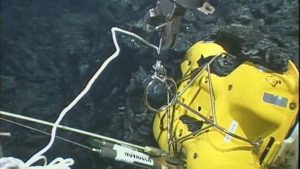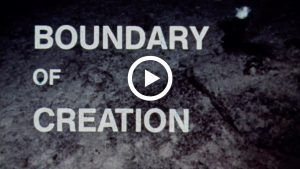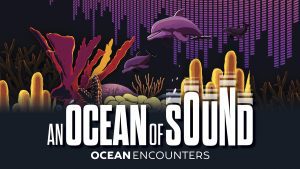By Daniel Hentz | 9/25/20
DANNY: Those are the busy grunts of Atlantic Puffins—a small species of penguin-like bird with a bright, charismatic orange and black striped beak. It’s fair to say these cliff-dwelling animals are conditioned to a raucous environment. Their habitat is a virtual Swiss cheese of coastal cliff burrows that’s blasted 24/7 with the boom and crash of waves and wind. But scientists are still concerned that even here, amid the noise of Europe’s rocky cliffs, humans may still be too disruptive for these feathery neighbors.
ARAN: Human voices, maybe hikers passing by, or tourists kind of passing by a nest can actually have disturbances on those animals.
DANNY: That’s Dr. Aran Mooney, a biologist here at Woods Hole Oceanographic Institution. He studies how marine animals hear and respond to sound in the world around them. And since 2017, he’s been here in Northern Iceland, catching puffins and analyzing their hearing to learn more about how they perceive and react to the soundscape.
ARAN: They’re not just influenced by loud sounds, like a jet going overhead; But they’re also influenced by relatively quiet sounds. That disturbs them enough to leave the nest often times. And actually that has indirect effects: it’s not that the egg gets cool or anything, but it’s actually making the eggs more susceptible to predation, predation by rats or gulls and that kind of thing. And so we have these secondary effects that low level noises can have on animals.
DANNY: Mooney refers to these small auditory increases as our “sound footprints.” These aren’t too different from our carbon footprint, but instead of generating harmful emissions, we’re creating an increasingly noticeable hum of noise that can disrupt the Earth’s natural chorus.
ARAN: We often think of the really loud sounds like underwater explosions or drilling for oil or maybe sonar. But small increases in the background noise, at least small disturbances can really influence the animals.
DANNY: And while chatting with a friend by the coast might seem pretty innocuous, Mooney says it’s the additional stressors of climate change that’ve made these sounds that much more of a burden on puffins, who traditionally communicate in the low pitched grunts you heard earlier.
ARAN: Just in the times that I’ve been in Iceland the past ten years or so, we’ve seen them move from dense colonies in the south, in the Westman islands, to now being mostly in the north of Iceland. And so they’re moving more northward, their food, which is often sand lance (these small fishes), are moving more northward as well. And so their habitat is really changing for a variety of reasons.
DANNY: To puffins our disembodied human noise is anxiety-inducing, the same anxiety they might feel when avoiding a predator.
ARAN: If you’re an animal, for example that lives in an area that has a lot of human activity, and activity that’s simply noise-based, like you can’t see the people but you can hear them. Those noises can induce stress or cause changes in behavior that impact essentially the animal’s reproduction or communication capabilities. So we know that even at really low levels can impact animals.
DANNY: On island archipelagos like the Farne Islands northeast of England, some reports suggest local puffin populations have seen as much as a 30% decline in their size as a result of climate pressures. So, after years of studying sound in animals, Mooney says it’s clear that our impact on noise may have the furtherest reaching consequences across the animal kingdom.
ARAN: What’s amazing is that we’ve never really found a deaf animal, or a deaf species, right? You know, we have blind cavefish and, you know, moles that don’t really see very well, and that kind of thing. We have animals that have many different sensory deprivations, but hearing is really sort of consistent across animal taxa. These puffins are diving down to 100-150 maybe 200 meters at some points. So we know there’s a lot of pressure down there. And so, one thought was that, maybe they wouldn’t hear very well on land, because they’re so well adapted to underwater. We found that was not true. They have as good a sense of hearing as good as any other bird species.
DANNY: Puffins have become a canary in the coal mine, but for endangerment of wild soundscapes, unimpeded by bustling humans.
ARAN: Even just in the areas we’ve been studying puffins we’ve worked in somewhat secret habitats, meaning there aren’t a lot of tourists visiting these areas. But you do see folks that are finding them on maps or showing up in areas that you thought were fairly pristine. And it’s getting harder and harder to find those wild areas. You want to understand the impacts to these animals, but it’s already been shifted a little bit, right? These animals are already seeing this sort of human encroachment. So… It’s tricky.
DANNY: Music for this podcast was by Podington Bear provided by the Free Music Archive. You can follow Dr. Mooney and the Mooney Lab team by going to go.whoi.edu/Mooney. For Woods Hole Oceanographic Institution, I’m Daniel Hentz
This work was conducted with the support of U.S. Navy’s Living Marine Resources Program
Image and Visual Licensing
WHOI copyright digital assets (stills and video) contained on this website can be licensed for non-commercial use upon request and approval. Please contact WHOI Digital Assets at images@whoi.edu or (508) 289-2647.







